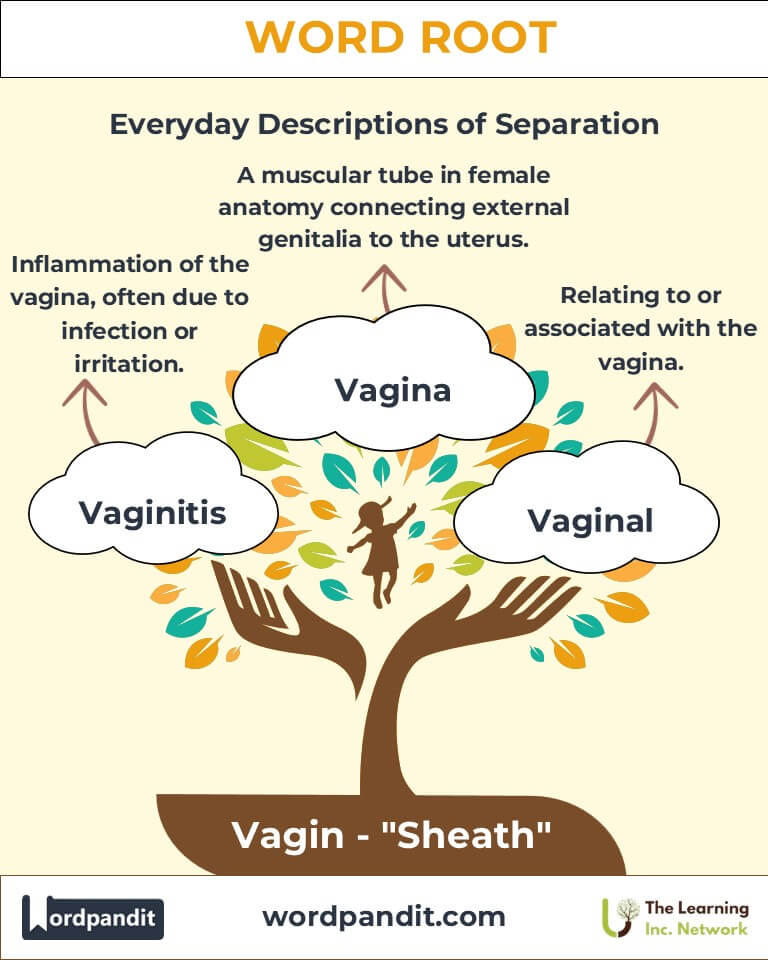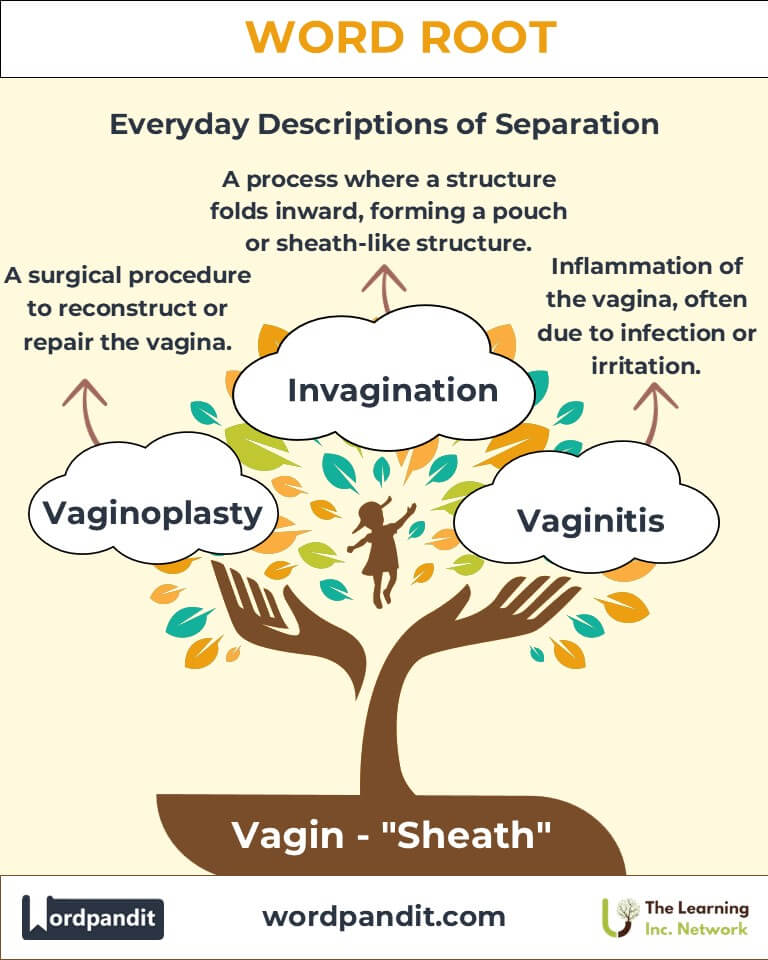Vagin: The Root of Enclosure and Protection in Anatomy and Beyond
Byline: Dive into the fascinating world of the root "vagin," derived from Latin and meaning "sheath." Found in terms like "vagina" and "invagination," this root encapsulates the concept of enclosure and protection, emphasizing its enduring relevance in anatomy and biological sciences.

Table of Contents
- Introduction: The Essence of "Vagin"
- Etymology and Historical Journey
- Mnemonic: Unlocking the Power of "Vagin"
- Common "Vagin"-Related Terms
- "Vagin" Through Time
- "Vagin" in Specialized Fields
- Illustrative Story: "Vagin" in Action
- Cultural Significance of the "Vagin" Root
- The "Vagin" Family Tree
- FAQs about the "Vagin" Word Root
- Test Your Knowledge: "Vagin" Word Root Quiz
- The Enduring Legacy of "Vagin"
1. Introduction: The Essence of "Vagin"
The word root "vagin" brings to mind a sheath, an enclosure offering protection or containment. Originating from Latin, the term serves as the linguistic backbone for words that describe anatomical structures and processes involving encasement or invagination. Whether in human biology or the broader context of protective layers, "vagin" signifies the profound interplay between form and function.

2. Etymology and Historical Journey
The root "vagin" stems from the Latin word vagina, which translates directly to "sheath" or "scabbard"—a protective covering for a blade. Historically, this metaphorical usage expanded into anatomy, describing structures resembling a sheath. Over centuries, its usage evolved to encompass processes such as invagination, illustrating its adaptability in scientific discourse.
3. Mnemonic: Unlocking the Power of "Vagin"
Visualize a protective sheath, like the scabbard of a knight’s sword, symbolizing safety and enclosure. The connection to anatomy becomes clear: structures like the vagina safeguard vital components, while invagination represents folding into a protective or enclosed form.
Mnemonic Device: "Vagin—like a sheath, enclosing and protecting with purpose."
4. Common "Vagin"-Related Terms
- Vagina (vuh-JY-nuh):
Definition: The muscular tubular structure in female anatomy connecting the external genitalia to the uterus.
Example: "The vagina plays a crucial role in the reproductive system." - Invagination (in-vaj-ih-NAY-shun):
Definition: The process where a structure folds inward, forming a pouch or sheath-like structure.
Example: "During early development, invagination is a key step in organ formation." - Vaginitis (vaj-ih-NYE-tis):
Definition: Inflammation of the vagina, often due to infection or irritation.
Example: "Vaginitis symptoms include discomfort and unusual discharge." - Vaginal (VAJ-ih-nuhl):
Definition: Relating to or associated with the vagina.
Example: "Vaginal health is a vital aspect of overall well-being." - Vaginoplasty (vaj-ih-noh-PLAS-tee):
Definition: A surgical procedure to reconstruct or repair the vagina.
Example: "Vaginoplasty is performed for both medical and cosmetic reasons."
5. "Vagin" Through Time
- Ancient Latin Usage: Initially, vagina referred solely to a sheath for weapons.
- Medieval Anatomy: Medical scholars adopted the term to describe tubular anatomical structures.
- Modern Usage: The root now informs both medical and metaphorical descriptions, including embryological processes like invagination.
6. "Vagin" in Specialized Fields
- Medicine:
- Vaginitis: Understanding infections and their treatment advances reproductive health.
- Developmental Biology:
- Invagination: Describes critical morphogenetic movements during embryogenesis.
- Surgery:
- Vaginoplasty: Restorative procedures use the root’s inherent meaning of reconstruction and sheathing.
7. Illustrative Story: "Vagin" in Action
Dr. Clara, a developmental biologist, studied the intricate process of invagination during embryo formation. She marveled at how cells folded inward to create the digestive tract, embodying the root "vagin"—a testament to nature's genius for creating enclosures essential to life.
8. Cultural Significance of the "Vagin" Root
The metaphorical use of "sheath" in language reflects its cultural significance, symbolizing protection and functionality. From medieval weaponry to modern anatomy, "vagin" reminds us of the protective roles in both physical and symbolic contexts.

9. The "Vagin" Family Tree
- Intro- (inward):
Example: Introvert (someone turned inward). - Cyst- (sac, bladder):
Example: Cystitis (inflammation of the bladder). - Plast- (mold, form):
Example: Plastid (a component of cells involved in storage and synthesis).

10. FAQs About " Vagin "
Q: What does "vagin" mean?
A: The root "vagin" means "sheath" or "enclosure," originating from the Latin word vagina. It refers to a protective covering or tubular structure that encloses or houses something, whether in anatomy (like the vagina) or biological processes (such as invagination).
Q: How does "invagination" relate to the root "vagin"?
A: Invagination refers to a process where a part of a structure folds inward, creating a pouch or sheath-like form. The term uses "vagin" metaphorically to describe the protective and enclosing nature of the resulting fold, which often serves as a foundational step in biological processes like embryonic development.
Q: Why is the term "vagina" used for the anatomical structure?
A: The term "vagina" was adopted because of its resemblance to a sheath or scabbard in both shape and function. It acts as a protective and connecting tube between external genitalia and internal reproductive organs, embodying the idea of an enclosure or sheath.
Q: What fields commonly use terms derived from "vagin"?
A: Fields such as anatomy, embryology, medicine, and surgery often use "vagin"-derived terms. These terms describe structures (e.g., vagina), processes (e.g., invagination), and medical conditions (e.g., vaginitis).
Q: What is the significance of vaginoplasty?
A: Vaginoplasty is a surgical procedure aimed at repairing, reconstructing, or altering the vagina. It is significant for individuals undergoing gender affirmation surgery, treatment after traumatic injuries, or for addressing medical conditions like vaginal prolapse, showcasing the root’s focus on structure and form.
11. Test Your Knowledge: " Vagin " Mastery Quiz
1. What does the root "vagin" signify?
2. What does "invagination" describe?
3. What is vaginoplasty?
4. Which term refers to inflammation of the vagina?
5. What field studies the process of invagination?
12. The Enduring Legacy of "Vagin"
The root "vagin" reminds us of the profound connections between form, function, and protection. Whether describing anatomical structures or biological processes, its role in language emphasizes the beauty of nature’s designs. Let the legacy of "vagin" inspire curiosity about the hidden intricacies of life.












